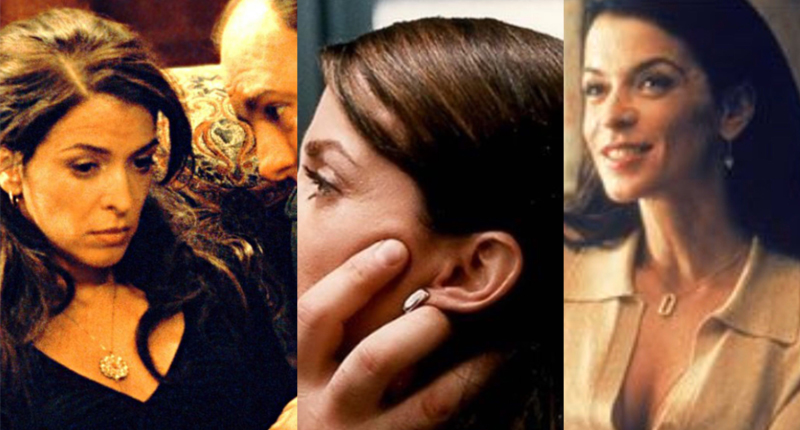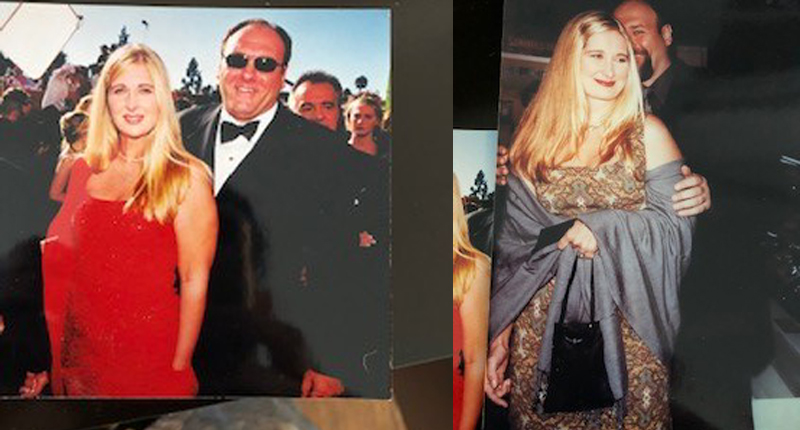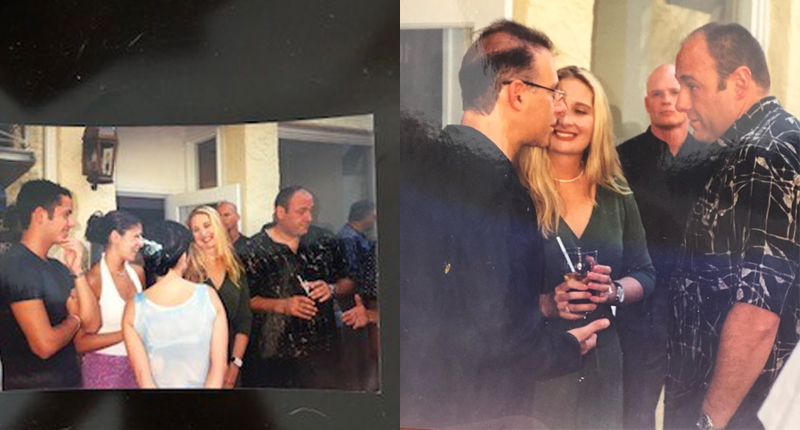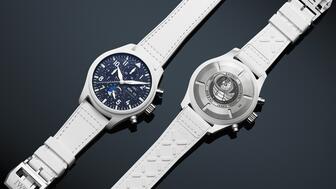Said to be the first to write a jewelry sales manual for the industry, Zell is remembered for his zest for life.
The Jewelry Insider’s Guide to ‘The Sopranos’
A well-known woman in the jewelry world helped shape the stylistic narrative of one of the most iconic television series of all time.

You might know Lauren Kulchinsky Levison as the uber-fashionable proprietor of family-owned and -operated Mayfair Rocks, snapped by street-style photographers in an array of to-die-for designer gowns heading into fashion shows in New York, London, Milan and Paris.
Or maybe you recall Levison as only the second woman to be inducted into National Jeweler’s Retailer Hall of Fame in 2002, when she was 31 years old (at the time, the youngest inductee).
Before dedicating herself to the fourth-generation family business Levison was an actress, perhaps explaining her ease with having all eyes on her.
But her most surprising role was totally behind-the-scenes, for no pay and little credit, when she styled the jewelry for “The Sopranos,” arguably one of the most iconic television shows of our era and one I began watching for the first time while quarantined at home.

The HBO show ran from 1999 to 2007, heralding the current Golden Age of television, bringing the kind of character-driven, meaty roles typically reserved for film to the small screen. (In fact, creator David Chase originally conceptualized “The Sopranos” as a feature film.)
Levison found her way to “The Sopranos” by way of the show’s lead, the late James Gandolfini. The two got to know each other through New York’s close-knit acting community, meeting on set of the 1996 film “The Juror.”
Levison had already inadvertently been dabbling in blending her worlds —acting and jewelry/watches—on the set of the 1990s TV series “New York Undercover.”
“The guys were wearing fake TAG Heuers,” she noted. “They were empty. There was no movement.”
A crew member knew Levison’s family was in the jewelry business and asked her to help him buy a watch he wanted. Soon, she was helping the busy cast and crew pick out gifts for their significant others, bringing items from jewelry store to set.
Actors also wanted to wear watches—the real deal—on camera. Levison supplied pieces on loan and was charged with handling them.
“I was just happy I was still working,” she said. “It was really hard to be a New York actor at that time, let alone part of a weekly episodic show. I got a job on a movie set for the summer and word got out that I was ‘the jewelry girl.’”
A few years later, Gandolfini gave Levison a call. He had just booked the pilot for a new HBO show—“The Sopranos.”
“He said, ‘You should see if you can get on it,’” Levison recalled. “I said, ‘What, am I going to just call and see if I can get on it?’”
The pilot was already cast, but Gandolfini suggested she act as a stand-in to be part of the production.
“I get there and I was literally standing in for Jamie-Lynn Sigler, Lorraine Bracco and Michael Imperioli, and they were all different heights,” she laughed.
“How are you supposed to be the best Carmela you can be if you’re in fake jewelry? Tony would never have his wife in fake jewelry. She’d be in the best he could bring home.” – Lauren Kulchinsky Levison
She couldn’t help her jewelry and watch expertise from creeping into her job description, again.
“I started to notice that Edie Falco was in this mesh necklace, tons of chains, a big cross, and it was all fake.”
Levison thought the look was right for a mob wife, but not the quality. She had her own ideas of how to amplify characters’ stories through jewelry, plus an all-hands-on-deck helpful attitude that had been honed through years of theater.
“Growing up in show business, [a production] is a group effort. You want to make the best show possible. You want the group to succeed. In New York, it’s a tight-knit community. You’re one big family. There was no separation between the cast and crew.”
With that, an accidental jewelry stylist was born.
Levison received copies of the closely guarded script, typically only given out in bits and pieces on an as-needed basis, to fulfill her costume design needs.
“It was never, well I’m going to make this about me and my jewelry,” Levison explained. “It was about making [the look] authentic and real, and developing how and why pieces would be worn. It was about getting into character and making sure an actor’s character is dressed. That was the main hole.
“How are you supposed to be the best Carmela you can be if you’re in fake jewelry? Tony would never have his wife in fake jewelry. She’d be in the best he could bring home. How can Lorraine Bracco’s character, Dr. Melfi, be in something fake when she’s trying to teach someone to be their authentic self?”
Levison supplied Breitling watches for the show’s male Mafia characters, like Gandolfini, Imperioli and Steven Van Zandt (better known to some as Little Steven from Bruce Springsteen’s E Street Band). Gandolfini wore a medallion on a curb-link chain that was his own.
“There’s a mesh necklace that you’ll see [worn by Edie Falco’s character, Carmela Soprano] and it looks like it’s fabric and that’s Christian Tse,” Levison recalled. “He was just starting out. Everyone wanted that necklace. I must have sold 20 a week of that necklace.”
It was an “elevated” take on a similar item Falco sported in the pilot episode, Levison noted, and Carmela wore some version of it as her layering “base” piece every season.
The necklace, worn among Carmela’s gold layers, carried a special symbolism Levison associated with the character, the matriarchal cornerstone of an Italian-American family.
“I wanted something that looked almost like fabric because it was reminiscent of a family quilt. She was in charge of the family; she makes the sauce, she makes the food.”
Lorraine Bracco expressed a preference for Ten Thousand Things, so Levison sourced pieces from the New York-based brand for Bracco’s character, psychiatrist Dr. Melfi.
Drea de Matteo brought lots of visual notes for her character Adriana La Cerva (seen below), down to her long fingernails.
“She was really in charge of her wardrobe and jewelry,” said Levison.
One of her favorite characters to style was Gloria Trillo, played by Annabella Sciorra in season three.
“I’m really proud of that part. She was an elevated woman coming into Tony’s world. I was able to play more with pieces and style them as individual pieces instead of piled one on top of another.”
“The Sopranos” aligned with what Levison feels was the beginning of women purchasing jewelry for themselves.
“Women were watching jewelry they could emulate, beyond the basic pieces like the diamond studs. They saw a housewife wearing her jewelry and a professional woman wearing different jewelry every time you see her, in pieces that correlate with who she is.”
Sciorra’s character, Tony Soprano’s girlfriend, was a prototype of the self-purchasing woman.

Working as a Mercedes Benz salesperson, she proudly showed Tony the watch she bought herself after a good commission.
Levison dressed the character in lots of Antonini because, “it was sleek and modern and cool like she was.”
One particular piece that stood out was a personal pendant Levison loaned for the Gloria Trillo character.
“It was all hand-enameled on one side and had all rose-cut diamonds on the other side. I felt because she was such a dual personality, it was fitting for her. Sometimes we’d put it on one side or the other.”
“It was this perfect storm,” said Levison of women beginning to buy themselves the pieces they wanted, knocking down the old wait-to-be-gifted paradigm.
“It was a huge disruption in the jewelry industry when we went from giving jewelry as gifts to collections that work with fashion, to jewelry being considered an accessory instead of an inaccessible item.
“‘Sopranos’ was a really big part of that and I’m proud to have been involved in a small way.”

Just as Levison’s role as the set’s resident jewelry and timepiece whisperer came about organically, so did her transition from on-set jewelry costume design to red carpet styling.
As “The Sopranos” quickly rose to acclaim, she found herself styling many of the cast members’ red carpet jewelry looks, outfitting the actresses in incredible jewelry suites to go to the Emmys or Golden Globes.
At the end of each season, there was a special credit to Mayfair Jewelers for Levison’s assistance.
When Levison and her family opened their Hamptons outpost in 2000, “The Sopranos” cast was there to fete the occasion.

“It wasn’t even the strongest moment of “The Sopranos” heyday yet, only maybe the first 10 episodes maybe had aired,” Levison recalled, “and the whole town of East Hampton was shut down because nobody could get down Main Street; that’s how many people showed up.”
The legacy of the show is one Levison couldn’t have imagined as she shaped its jewelry narrative, script in hand.
The best part was, “just being in the presence of these actors, how David Chase put them all together,” she said.
“I had never read anything like that for TV. I stood in for a boy, that’s how much I wanted to be a part of that show. I would have held a light to be there every day.”
“Jim had come to my family’s business [at the old store location in Commack, New York]. It was out of the blue, he just showed up. He bought his engagement ring for [first wife] Marcy from me. He saw the business and saw how I worked with my family.
“He said to me, ‘I don’t know why you even come to set, you should be a jeweler full time you’re so good at it and your family is so wonderful.’
“I started to not do anything but drop the jewelry off, pretty much, and go in for certain, really strong acting scenes, and I started to do jewelry full time. I have Jim to thank, I think.”
Gandolfini, who died unexpectedly in 2013, was a major influence on Levison.
“I stopped walking both lines after that [conversation]. I was still dressing the actors for awards and bringing jewelry over but I wasn’t pursuing acting anymore. Jim Gandolfini was one of the greatest people in the entire world and he set the tone for an incredible work environment. He was an amazing guy.
“I miss Jim a lot.”
The Latest

The company outfitted the Polaris Dawn spaceflight crew with watches that will later be auctioned off to benefit St. Jude’s.

A buyer paid more than $100,000 for the gemstone known as “Little Willie,” setting a new auction record for a Scottish freshwater pearl.

Supplier Spotlight Sponsored by GIA.

Anita Gumuchian created the 18-karat yellow gold necklace using 189 carats of colored gemstones she spent the last 40 years collecting.


The giant gem came from Karowe, the same mine that yielded the 1,109-carat Lesedi La Rona and the 1,758-carat Sewelô diamond.

The three-stone ring was designed by Shahla Karimi Jewelry and represents Cuoco, her fiancé Tom Pelphrey, and their child.

Supplier Spotlight Sponsored by GIA

The Manhattan jewelry store has partnered with Xarissa B. of Jewel Boxing on a necklace capsule collection.

Acting as temporary virtual Post-it notes, Notes are designed to help strengthen mutual connections, not reach new audiences.

The jewelry historian discusses the history and cultural significance of jewelry throughout time and across the globe.

From fringe and tassels to pieces that give the illusion they are in motion, jewelry with movement is trending.

The designer and maker found community around her Philadelphia studio and creative inspiration on the sidewalks below it.

The change to accepted payment methods for Google Ads might seem like an irritation but actually is an opportunity, Emmanuel Raheb writes.

The industry consultant’s new book focuses on what she learned as an athlete recovering from a broken back.

The fair will take place on the West Coast for the first time, hosted by Altana Fine Jewelry in Oakland, California.

Hillelson is a second-generation diamantaire and CEO of Owl Financial Group.

Submissions in the categories of Jewelry Design, Media Excellence, and Retail Excellence will be accepted through this Friday, Aug. 23.


Known as “Little Willie,” it’s the largest freshwater pearl found in recent history in Scotland and is notable for its shape and color.

Clements Jewelers in Madisonville cited competition from larger retailers and online sellers as the driving factor.

The gemstone company is moving to the Ross Metal Exchange in New York City’s Diamond District.

Most of the 18th century royal jewelry taken from the Green Vault Museum in Dresden, Germany, in 2019 went back on display this week.

The Pittsburgh jeweler has opened a store in the nearby Nemacolin resort.

With a 40-carat cabochon emerald, this necklace is as powerful and elegant as a cat.

The Erlanger, Kentucky-based company was recognized for its reliability when it comes to repairs and fast turnaround times.

Unable to pay its debts, the ruby and sapphire miner is looking to restructure and become a “competitive and attractive” company.

The trend forecaster’s latest guide has intel on upcoming trends in the jewelry market.



























